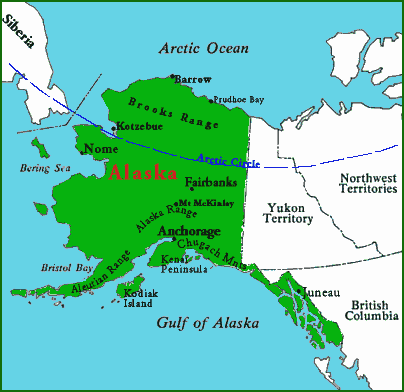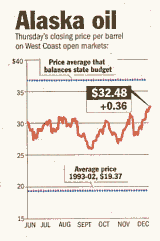A few facts about The Great Land
 Alaska's vast territory (1,478,960 km ²) is home to 644,000 people,
making it the state with the lowest population density in the United States.
Almost half the population of the state lives in Anchorage. Alaska has an
abundance of moose, bears, wolves, fish, eagles, oil, gold, volcanoes, mountains,
tundra, glaciers, and earthquakes. Alaska also has Mt. Mckinley, the tallest
mountain in North America at 6,194 meters (20,320 ft.).
Alaska's vast territory (1,478,960 km ²) is home to 644,000 people,
making it the state with the lowest population density in the United States.
Almost half the population of the state lives in Anchorage. Alaska has an
abundance of moose, bears, wolves, fish, eagles, oil, gold, volcanoes, mountains,
tundra, glaciers, and earthquakes. Alaska also has Mt. Mckinley, the tallest
mountain in North America at 6,194 meters (20,320 ft.).
The aboriginal inhabitants might have followed game migrations from Siberia at various times or gradually moved into the unglaciated Alaskan interior during the most recent ice age, between 15,000 and 50,000 years ago (Langdon 1993) . So much water was locked up in glaciers world wide that sea levels of that time had dropped 100 meters lower than present levels. The Bering Sea virtually disappeared and a huge swath of land 1600 km wide connected Siberia and Alaska in a great land mass called Beringia by archaeologists. This "land bridge" was not narrow but was almost as wide as Alaska. The dates of earliest occupation in Alaska is a controversial topic among archaeologists. So far, the oldest "microblade" artifact found has been dated to 11,500 ya.
Alaskan Natives were composed of many different groups with long cultural traditions when they first traded furs to the Russians in southeast Alaska about 1750. This remote subcontinent was the last area of North America to be settled by Europeans. Captain James Cook, under orders from the British Admiralty to locate the Northwest Passage, sailed into what is now called Cook Inlet, in 1778. Anchorage, as its name indicates, eventually became the preferred landing at the northern end of Cook Inlet, and remains Alaska's largest port. Turnagain Arm, a fjord of Cook Inlet 10 km south of Anchorage, is shown below during midsummer.
 Alaska
is owned by Native corporations and state and federal governments. Less than
1% of Alaska is privately owned (Alaska Atlas and Gazeteer. 2001).
Most of Alaska is a roadless wilderness requiring air or water transport for
access. Outside of the few urban areas, Alaskans live in small remote villages,
connected by motor boats, barges, air taxis, dog sleds and snowmachines. Fairbanks,
Alaska's second largest city including the surrounding North Star Borough,
has a population of almost 70,000. Juneau, the state capital, has a population
of 30,000 and is not accessible by road so most Alaskan's have never gone
there.
Alaska
is owned by Native corporations and state and federal governments. Less than
1% of Alaska is privately owned (Alaska Atlas and Gazeteer. 2001).
Most of Alaska is a roadless wilderness requiring air or water transport for
access. Outside of the few urban areas, Alaskans live in small remote villages,
connected by motor boats, barges, air taxis, dog sleds and snowmachines. Fairbanks,
Alaska's second largest city including the surrounding North Star Borough,
has a population of almost 70,000. Juneau, the state capital, has a population
of 30,000 and is not accessible by road so most Alaskan's have never gone
there.

There is no state income tax and no sales tax. The State makes its money on oil royalties. Almost all of the state's oil comes from the "North Slope" at Prudhoe Bay. As long as oil prices stay near $30.00 US per barrel, as the clip from yesterday's paper (12-18-03) shows, we're rolling in clover. Alaskans receive an annual dividend earned by investments made by the Alaska Permanent Fund which was established by the state constitution as a savings account for a portion of the oil revenues. Every man, woman, and child who is a legal resident (one year in residence) receives the dividend. The dividend in 2003 was $1107.56 US per person. In 2002 the permanent fund dividend was $1540.76 US.
Alaska is a land of extremes. The sun doesn't set in the summer above the arctic circle and in the winter it doesn't rise. Winter low temperatures of -40°C to -60°C (-80°F) in the interior have been recorded. Snowfall in the Anchorage area is about 2m each winter, but at Valdez, the terminal of the Trans-Alaska Pipeline, snowfall averages about 8 meters.